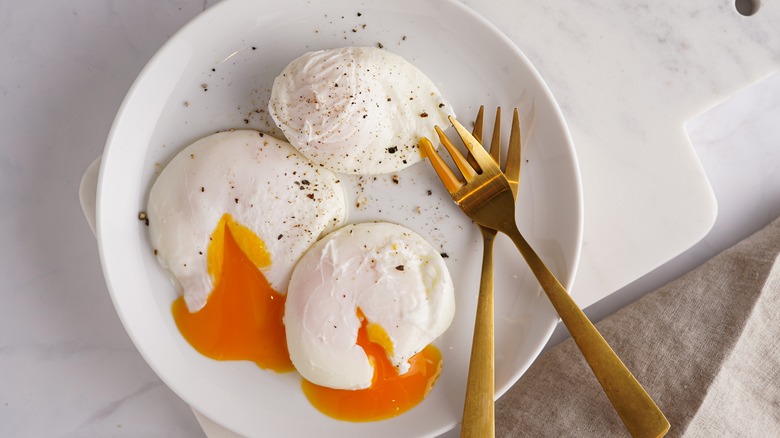The Common Step Kristen Kish Skips When Poaching Eggs - Exclusive
Of all the methods to cook eggs in the world, few preparations elicit as strong of an opinion as poaching. The library of chef-inspired tips for poaching eggs is not only expansive when it comes to the technique, but it also zooms in on every step of the process — from before the egg even leaves its shell to how a home cook should rest their egg after it's poached (and before it's served).
Recently, Tasting Table sat down for an exclusive interview with Kristen Kish, the new host of Bravo's "Top Chef." Although the conversation primarily focused on holiday cooking and the upcoming 21st season of the show, we also had the opportunity to discuss some cooking techniques with the former winner and classically trained chef. Naturally, we had to ask Kish about her steps for poaching a perfect egg, and surprisingly, she mentioned there's actually a common ingredient that she leaves out of the process.
"I understand a lot of people use vinegar — either presoaking or in the water, which can lend itself to a prettier poached egg," said Kish. "But when it comes down to a great poached egg, you don't need it."
Why vinegar is often recommended for poached eggs
For many home cooks and celebrity chefs alike, vinegar has become an indispensable part of poaching an egg. The reason why comes down to food chemistry. Within the shell of an egg are two main parts you're probably familiar with: the yolk and the egg white. Each of these parts consists of numerous components, but the egg white contains a significant amount of the protein ovalbumin.
While a yolk holds its shape when cracked, egg whites expand thanks to a significant amount of water content. This spread is great if you're trying to fry an egg for a sandwich, but not so much if you need it to hold the round shape indicative of a perfectly poached egg. When heat is applied to proteins, however, denaturing occurs. This is the process wherein a protein solidifies and, in the case of an egg, stops spreading and begins to firm up.
Heat isn't the only thing to spark this process — introducing acid kick-starts denaturation, too. Add a splash to your boiling water, and it's an easy way to help an egg hold its shape as you poach it. Creating a vinegar solution can be a helpful shortcut for poaching eggs, but in the end, as Kristen Kish says, it's not essential; heat is the part that cannot be replaced.
What Kristen Kish says you really need
When it comes to poaching eggs, Kristen Kish has a hot take. "This may be an unpopular opinion," she told us, "but all you need is water, a slotted spoon, and the right-sized pan." In this opinion, Kish is actually supported by a chorus of other well-regarded chefs and their egg-poaching techniques.
One way to get by with the tools Kish recommends (and without the vinegar) is to follow Julia Child's guidance. She advised home chefs to prick a shelled egg with a small pin and then boil it for 10 seconds. This allows denaturing to start while keeping the egg in a sort of mold. After the pre-boiling, home cooks can crack the egg into the water and will find that it holds its shape as it poaches.
Similarly, Chef Jaime Oliver works on letting hot water do the trick. Oliver creates a whirlpool in the pot, where the egg then keeps its shape as it spins in centrifugal motion. This technique matches Kish's requirements, as all you need for the technique is hot water and a spoon to scoop with.


